Anchoring Devices – Best Choice for Comfortable Teeth
During recent years, researchers and bioengineers in the field of dentistry have developed an implant solution that has created, for many patients, the best choice of available alternatives for securing dentures with excellent predictably as an enduring treatment.
Common reports of loose fitting, painful, loss of confidence in eating, speaking and laughing are now becoming a thing of the past for patients who undergo this near effortless treatment.
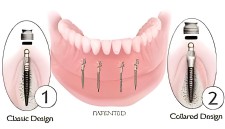
A growing number of Wisconsin dentists, in addition to Dr. Winter, now have access to the new IMTEC mini denture implant device that enables patients, in many instances, to use their current dentures for creating teeth that become affixed to the lower jaw (mandible).
Minimally Invasive Mini Dental Implant Placement: Procedure Description
Implants have been used in one form or another for thousands of years. Over the last 40 years with technological advances and understanding of implant integration, there has been an exciting increase in patients that can benefit from implant dentistry.
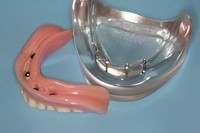
While dentures for years have been thought of as a final procedure, the current standard of care is to include implant stabilization of lower dentures.

Review our Denture to Implant Conversion page to see more step by step surgery photos and to watch several live video testimonials featuring the patient’s discussion covering 6 important aspects of mini implants.
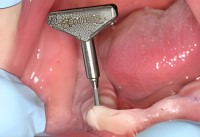
Two implant solutions are available for most patients. The use of implants with balls that provide attachment to dentures having rubber gaskets is popular. A second, more stable option is to use a bar overdenture attached to standard dental implants.
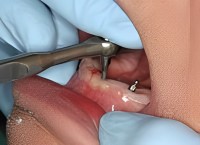
Mini-implants are titanium screws that measure 1.8 to 2.4 mm in diameter that are approved by the FDA for long term use. In contrast, traditional implants (root form) are between 3mm and 6mm in diameter by comparison.
Indications for Mini Implants
- Financial limitations; since they are placed and restored by the same doctor and are less expensive than traditional implants they are a less costly procedure by 1/3-1/2 the cost.
- Anatomical limitations; they can be placed in situations were standard implants can’t fit. If the bone is as thin as 3mm a mini can be used, whereas a 3mm traditional implant would require 7 mm of bone thickness to restore the same site.
- Anatomic limits; if a patient is told they need bone grafting to place implants, the mini implants can be used to avoid the grafting procedure.
While these statements DO NOT imply mini-implants are better than traditional implants, they may represent the best solution for the above limitations. Sensible treatment planning includes availability of specialty implants when traditional devices are a questionable option without additional treatment (possible bone grafting).
Mini implants are now commonly used to stabilize loose partials, repair failing bridges or replace narrow teeth where grafting and cost prohibit regular implant placement.
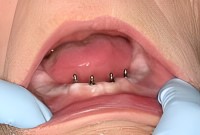
Research is currently being conducted to evaluate mini-implants for replacement of bridges. Preliminary results appear favorable.
Implants are restoration driven. Placement of the implant is determined by how and where the teeth need to be placed. The limitations addressed above involving cost and insufficient bone can be easily overcome for many patients with miniaturized implants.

Procedure Description
Mini-implants are diagnosed as an option.. A minimum of 12 mm of bone height is needed for implant stability with good access and absence of infection.
At least 3 mm of bone are needed in a front to back direction as well. The area is anesthetized after locating nerve structures.
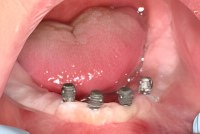
The implants are often placed with NO incision. A puncture is made and the implants are threaded into the available bone with a plastic carrier, a hand wrench, thumb wrench and ratchet wrench.
These implants are self-threading and they are placed in bone that is solid so slow and meticulous placement is mandatory.
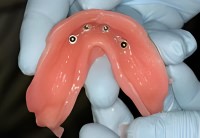
The denture is marked and the internal surface relieved before picking up the attachment with self-curing plastic resin. A rubber gasket and cap is placed on top of the mini implant head and by using acrylic the cap is fixated to the denture directly in the mouth.
The bite is checked to assure normal dental function and occlusal relationships. For most patients the dentures can be used immediately for eating and chewing comfortably. In unusual treatments where incisions in the soft tissues or bone quality remains compromised, soft denture liners are provided to assure comfort while tissues are healing.

Call 414-464-9021 for information on any of our services.
Check out our Dental Blog >>
Read our Patient Case Studies >>
Hampton Dental Associates is proud to offer affordable dentistry programs to help you regain your perfect smile.
Learn more about our affordable dentistry options.



